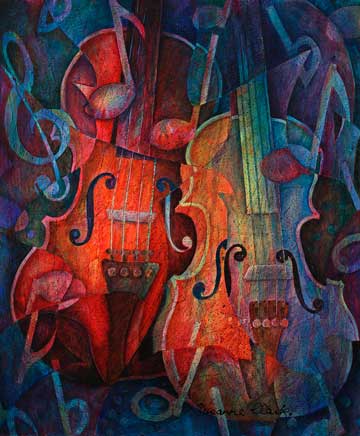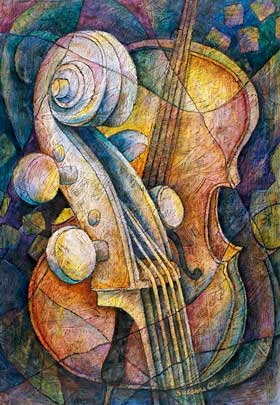Concert
A Far Cry
Pickman Concert Hall
Longy School of Music
Cambridge, MA
December 17, 2023
Wolfgang Amadeus Mozart
String Quintet No. 6 in E-flat Major, K. 614
I. Allegro di molto
II. Andante
III. Menuetto: Allegretto
IV. Allegro
Annie Rabbat, violin
Miki Cloud, violin
Sarah Darling, viola
Caitlin Lynch, viola
Rafi Popper-Keizer, cello
Franz Schubert
String Quintet in C Major, D. 956 Op. Posth. 163
I. Allegro ma non troppo
II. Adagio
III. Scherzo. Presto – Trio. Andante sostenuto
IV. Allegretto
Miki Cloud, violin
Annie Rabbat, violin
Caitlin Lynch, viola
Rafi Popper-Keizer, cello
Francesca McNeeley, cello

by Susanne Clark
Image: Fine Art America
One of the great things about A Far Cry, Boston’s now established (since 2007) magnificent and democratically run string ensemble, is that all of its members take turns producing and curating the programs. This program, produced by violist Caitlin Lynch, features the last chamber music written by Mozart and Schubert, coincidentally both string quintets, one featuring two violas and the other featuring two cellos. In a charming and informative preamble to the concert, Lynch offered that the Mozart quintet is seemingly not well known and not often played, and she noted that none of those onstage for this performance had played it, and few of them had listened to it. That’s odd, given that it’s Mozart and that the players are all very well-versed, but I suppose it’s just one of those strange things that this last of Mozart’s chamber works got stuck in some kind of backwater.
The piece is not among the greatest Mozart wrote, but it’s not bad. As Lynch noted, Mozart was ill and penniless at the time of its composition and had every reason to make it grim, but he chose otherwise. It is a perky piece, truly emblematic of Mozart and particularly emblematic of the composer of The Magic Flute, the very great but also very playful opera composed a bit earlier than this string quintet in 1791, the last year of Mozart’s life.
The Schubert quintet has gained prominence in the annals of chamber music, despite that, as Lynch noted, it was published posthumously and not performed until twenty-two years after Schubert’s death. Apparently, Schubert had sent it to his publisher and received no positive reply, instead getting an appeal for more songs. We are all certainly glad that someone uncovered the piece before it got lost to the elements and that it ultimately deservedly received its lauded status. It is truly one of the great chamber works.
A Far Cry is consistently an excellent group of players and here, in its smaller selected array for these quintets, some truly shining moments emerged. Both of these pieces are very busy and exposed in many places and one marvels at some of the challenges. Notably, A Far Cry is overall an ensemble in which crispness reigns, sometimes startingly so. In this performance, these Criers were eloquent and engaged, but, at times in some of the middle and lower registers there was a touch of cloudiness. It was hard to tell whether that was a function of the Pickman Hall acoustics, some of the instrumentation particularly in the Mozart, or something more difficult to identify. Apart from this, all the players shone in their own moments, and the interpretations were musically satisfying. Though all the players were excellent, I was particularly struck by violinist Annie Rabbat’s easy command, especially in the Mozart.

by Susanne Clark
Image: Fine Art America
Some specific notes on the performances:
Wolfgang Amadeus Mozart
String Quintet No. 6 in E-flat Major, K. 614
I. Allegro di molto
Light, lovely, fanciful opening theme. Wonderful interchange of theme between the violins and violas, full of frills and turns. The first section repeats, and everybody gets a turn, and they all rise to the occasion. A Violin I ascending scale goes above and beyond, and Annie Rabbat’s easy eloquence is visible throughout. In the development section there is much twilling and answering in minor mode, and, in the recapitulation, there are moments with this intricate back and forth like the vocal quintets in the operas such as Cosi Fan Tutte. The violas scrabble away next to the violins twittering away. Some slight modification in theme at the end adds to interesting variety, which leads to a rip roaring ending.
II. Andante
A measured, stately opening, and there are no surprises at the outset. Dignified. Then a mournful extension – understandable given Mozart’s circumstances in this last year of his life – opened by the cello, which leads back to some variations on the dignified opening. The mournful interlude shortens, then feeds back quickly to the dignified theme from the beginning. But, then, in true Mozartean style, it gets knotted up. It feeds to a more interwoven aria as though the voice of balanced reflection gives rise to a bit of a sparkle. An exploration of the amalgamated theme with a few more flourishes leads to a delicate ending.
III. Menuetto: Allegretto
A measured, pro forma, entry, then the obligatory minor detour followed by a kind of groveling and slurping to counteract the light delight. A singing Trio follows with elongated wavering runs, almost alcoholic song by a drunk rumbling home on a country road, not unhappily. The genteel minuet returns, very dignified, and ends with a flourish and a singular simple goodbye from the cello.
IV. Allegro
A rollicking good tune. Rabbat’s Violin I noticeably eloquent with its fast passages and the interplay between Violin I and Miki Cloud’s Violin II noticeably satisfying as is the dialogue between Violin I and Sarah Darling’s Viola I, with some of the frivolity of The Magic Flute suggested. It halts, slows, reflects, then shreds the themes in a hectic scramble for everyone to declare themselves. The main theme then returns with its minor adaptation for a moment to raise its negative thought which tilts back in short order to the energetic positive, though the serenity perseveres. Then they all dig in a ferocious interplay nicely carried off by all members of the ensemble. The theme alternates in a tease with the violas pulling the taffy beautifully and the movement and quintet end with a dignified attenuation.
A nice piece, though at times a bit hectic, and hard to tell why it has not been more popular.
Franz Schubert
String Quintet in C Major, D. 956 Op. Posth. 163
I. Allegro
A lovely serene opening by the two violins and a nice cello intro by Rafi Popper-Keizer’s Cello I. An emergence into the main theme, and the celli take it away, with Popper-Keizer and Francesca McNeeley’s Cello II singing together in the beautiful interplay of their introductory duet. The harmonies here are gorgeous, nicely rendered by the cellos. Then the violins interact, very sweetly. Nice work scrambling quick notes on Violin II by Annie Rabbat, with nice leading on Violin I by Miki Cloud. The punctuated hunting through the woods that ensues done clearly and nicely by everyone. Then more and more, in endless repetitions. Then a strong bottom from McNeeley’s Cello II. Cloud’s Violin I takes it away nicely. The repeat comes – the cellos attenuate the memorable theme with elegance and a compelling unison. Caitlin Lynch’s Viola keeps up well. Now the Viola and Popper-Keizer’s Cello I do the wonderful introductory theme again beautifully. The violins follow it up with the theme done sweetly and elegantly, with Rabbat’s Violin II interleaving gracefully. Lynch’s Viola shines with an unsparingly fast and difficult passage. In the clipped march that follows, the all sing together beautifully and it finishes nicely with a touch of gravitas.
II. Adagio
Cloud’s Violin I chants charmingly, while Keizer-Popper’s Cello I does the bass plucking effectively. Then Rabbat’s Violin II, Keizer-Popper’s Cello I and Lynch’s Viola hold down the harmonic fort. Cloud’s Violin I holds forth eloquently with just a few notes at her disposal. A subtle pluck fest between Cloud’s Violin I and McNeeley’s Cello II takes off while the others provide the sauce. Cloud’s Violin I has to alternate between plucking and arco and she does it elegantly. There are some subtle and difficult to articulate intonations here. Then the gentility breaks. McNeeley’s Cello II does the ferocity thing well and forthrightly. Lovely theatric elongation from Cloud’s Violin I while McNeeley’s Cello II goes at the lower register. Lynch’s Viola holds her own with the not easy syncopated alternations. McNeeley’s Cello II sings above the crowd with intricate lower register meanderings. Then a paused transition. Where is this going? A chorus leads to along series of inventions by Cello II, as though they are trying to unwrap a package. Perhaps a little more gusto here from Cello II? An attenuated section, with lovely lyricism from Cloud’s Violin I, emerging into dark transition to the tonic home, then finis.
III. Scherzo. Presto. Andante.
An energetic start. The cellos have it, and their runs are scrambles, but generally pulled of pretty well. The ensuing clarion calls from cellos are lovely, and Lynch’s Viola holds it own nicely. Popper-Keizer’s Cello I scratches around quickly, then Cello I and McNeeley’s Cello II are off scrambling together again. The transition to slow and stately Andante nicely pulled off, with Lynch’s Viola and McNeeley’s Cello II exhibiting elegance. Relaxing and elongated: are we asleep yet? Just wait! Grave, molto serioso. It goes on, and on. And then, it returns to its original manic craziness, full of clarion calls, changes of key and all the romping. Again, the scrambling by the cellos together ends with a flourish.
IV. Allegretto
Now, it’s even more of a romp and the violins are playing gypsy tunes, or is this circus music? Whatever it is it’s a joke, it’s fun. Then it turns lyrical with Miki Cloud’s Violin I doing somersaults with arpeggios, with more acrobatics from Violin I which Cloud pulls off very well. The two violins stays in alternation with Popper-Keizer’s Cello I and Lynch’s Viola – beautiful, wonderfully intimate. And it all returns by hook and crook to the gypsy-circus theme. Now on to the development section, it’s complicated though the singular theme keeps returning insistently. Such nice interactions between Cloud’s Violin I and Rabbat’s Violin II with integrated backup from Lynch’s Viola. Some competent arpeggio scrubbing by Popper-Keizer’s Cello I. The dual cello aria return nicely, preceding the final scramble with everyone at it, full tilt. The two cellos scrub intensely and capably together, and then it all concludes with a moment of attenuation.
A great quintet, performed with some truly great moments.
– BADMan (aka Charles Munitz)
Leave a Reply